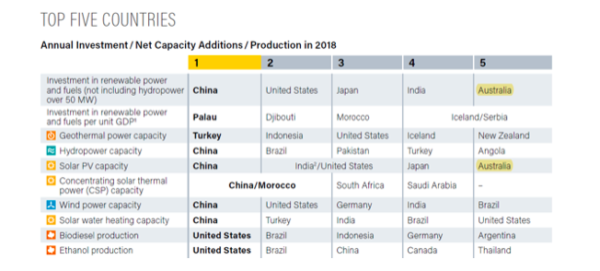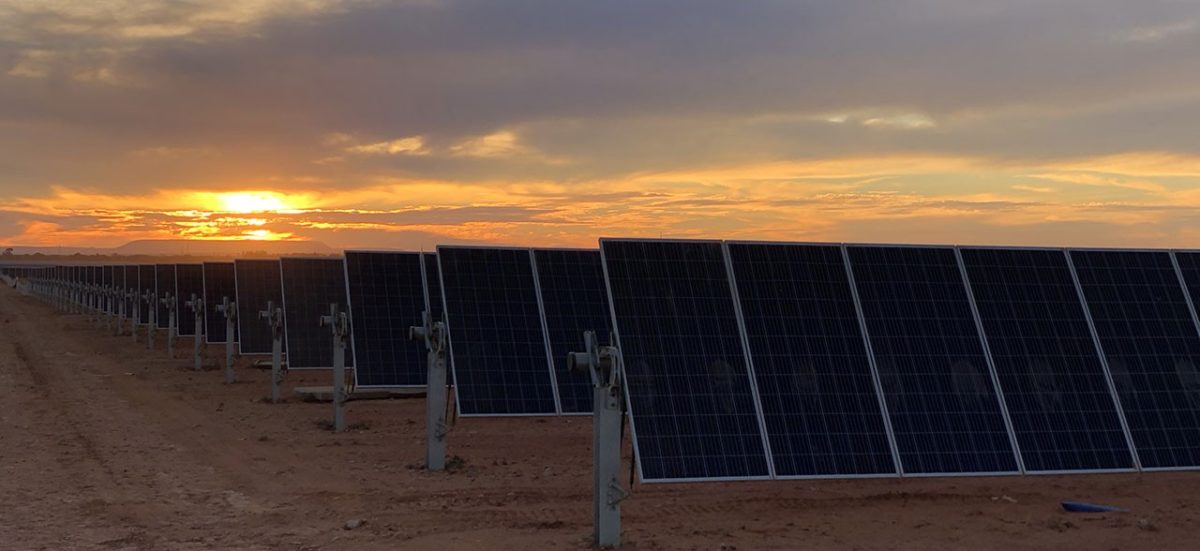Australia tops the global charts in terms of solar PV and battery additions in 2018, according to a report published by global renewable energy policy network REN21 this week. However, the fact sheet on Australia’s renewable energy trends is not all roses, with grid bottlenecks and wave developer Carnegie’s bankruptcy featured among critical highlights.
On the positive note, renewables represented over 20% of electricity generation for the first time. As a result, emissions in the Australian power sector continued a three-year decline during a record year for renewable power generation, REN21 states.
Last year also saw highest renewable energy investment in Australia to date totaling US$9.5 billion, while investment in small-scale distributed capacity topped US$1 billion. As a result, Australia ranked the world’s fifth largest investor in renewable power and fuels excluding hydro over 50 MW.

To keep up the pace with the strong uptake, the country is looking to invest in new transmission infrastructure to deal with the rising shares of variable renewable energy on the grid, states the report. In the policy arena, REN21 also points to a range of developments at the sub-national level in Australia, such as 44% reduction in New South Wales’ FIT rate for solar PV, South Australia’s $100 million Home Battery Scheme, and grid-scale batteries in Victoria partly financed by the federal and state governments.
Solar and battery storage
As solar PV installations tripled on the 2017 levels to about 3.8 GW, raising total capacity to more than 11.1 GW, Australia emerged as the fifth-largest market for solar PV worldwide. In 2018, the top five markets accounted for about three-quarters of new installed capacity, finds REN21.
Overall, solar PV accounted for 5.2% of Australia’s electricity generation, according to the report. Every state and territory broke records for new solar capacity, apart from Tasmania.
However, REN 21 also point to a range of concerns for solar PV developers including network constraints, delays, grid connection issues. As the rising share of rooftop and large-scale solar PV is reshaping Australia’s grid and challenging utilities, grid woes have become significant concerns for developers and have resulted in cost-overruns and reduced investor confidence, the report finds.
Indeed, difficulties in finalizing grid connection amid strenuous demands that the Australian Energy Market Operator is placing on renewables developers have delayed a number of large-scale projects across the country, undermining their economic viability. This has even caused developers to walk away from projects, or bear additional expenses to install components, such as costly synchronous condensers, in order to improve grid strength.
When it comes to systems integration and enabling technologies, Australia once again tops the charts. According to REN21, together with four other countries, Australia accounted for nearly 80% of new battery storage systems commissioned in 2018 worldwide.
Global trends
The REN21 report also provides an overview of global trends and finds renewable energy continues to make its presence felt in global electricity production with solar the third largest source. Presently, more than a quarter of global electricity is generated from renewable energy, but its integration in the heating, cooling and transport sectors still lags the progress needed to stave off climate chaos.
For full coverage of the report, see pv magazine global.
This content is protected by copyright and may not be reused. If you want to cooperate with us and would like to reuse some of our content, please contact: editors@pv-magazine.com.









By submitting this form you agree to pv magazine using your data for the purposes of publishing your comment.
Your personal data will only be disclosed or otherwise transmitted to third parties for the purposes of spam filtering or if this is necessary for technical maintenance of the website. Any other transfer to third parties will not take place unless this is justified on the basis of applicable data protection regulations or if pv magazine is legally obliged to do so.
You may revoke this consent at any time with effect for the future, in which case your personal data will be deleted immediately. Otherwise, your data will be deleted if pv magazine has processed your request or the purpose of data storage is fulfilled.
Further information on data privacy can be found in our Data Protection Policy.